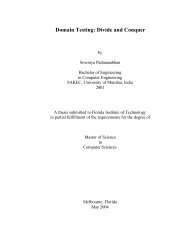appendix 1. analyzing the triangle problem - Testing Education
appendix 1. analyzing the triangle problem - Testing Education
appendix 1. analyzing the triangle problem - Testing Education
Create successful ePaper yourself
Turn your PDF publications into a flip-book with our unique Google optimized e-Paper software.
ANALYZING THE TRIANGLE PROBLEM<br />
(Continued)<br />
<strong>1.</strong> Verify that invalid inputs are rejected as expected (continued).<br />
(b) j is not valid<br />
The same types of tests are needed as for j as were needed for i.<br />
(c) k is not valid<br />
The same types of tests are needed as for k as were needed for i.<br />
How much testing of <strong>the</strong> second and third input lengths, j and k, is appropriate?<br />
If we can assume that <strong>the</strong> software engineer who developed <strong>the</strong> <strong>triangle</strong> software is<br />
reasonably competent, we can also assume with confidence that <strong>the</strong> software engineer<br />
would have provided one common subroutine to edit all of i, j and k at <strong>the</strong> time <strong>the</strong>y are<br />
input.<br />
In this situation, a comprehensive set of test cases for j and k, following <strong>the</strong><br />
comprehensive set of tests for i, is unnecessary. The first set of test cases for i will<br />
already have extensively exercised <strong>the</strong> common edit routine, so re-testing for several<br />
values of j and k would be redundant. If <strong>the</strong> software works for i, it should also work for j<br />
and for k.<br />
Only one additional test case is needed for j, and also one for k, to double-check that <strong>the</strong><br />
software engineer at least remembered to call or access <strong>the</strong> common edit routine for j<br />
and k as well as for i.<br />
A better approach (instead of many negative test cases for i, followed by only one each<br />
for j and k), is to spread <strong>the</strong> set of negative test cases equally among i, j and k.<br />
However, if we are paranoid, we will be willing to assume nothing. Since this is a black<br />
box test, we do not know for sure how <strong>the</strong> software was constructed internally. Although<br />
it may be an incompetent practice, <strong>the</strong> software engineer may have written three separate<br />
input edit routines, one each for i, j and k. In this circumstance, <strong>the</strong> fact that <strong>the</strong> first set<br />
of tests for i work correctly will predict nothing about <strong>the</strong> behavior of j and k.<br />
Copyright 2004 Collard 13 & Company<br />
Appendix 1<br />
13








